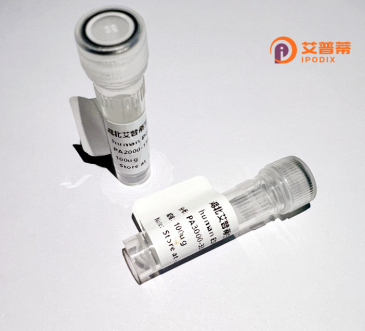
| 纯度 | >90%SDS-PAGE. |
| 种属 | Human |
| 靶点 | TFCP2 |
| Uniprot No | Q12800 |
| 内毒素 | < 0.01EU/μg |
| 表达宿主 | E.coli |
| 表达区间 | 1-502 aa |
| 活性数据 | MAWALKLPLA DEVIESGLVQ DFDASLSGIG QELGAGAYSM SDVLALPIFK QEESSLPPDN ENKILPFQYV LCAATSPAVK LHDETLTYLN QGQSYEIRML DNRKLGELPE INGKLVKSIF RVVFHDRRLQ YTEHQQLEGW RWNRPGDRIL DIDIPMSVGI IDPRANPTQL NTVEFLWDPA KRTSVFIQVH CISTEFTMRK HGGEKGVPFR VQIDTFKENE NGEYTEHLHS ASCQIKVFKP KGADRKQKTD REKMEKRTPH EKEKYQPSYE TTILTECSPW PEITYVNNSP SPGFNSSHSS FSLGEGNGSP NHQPEPPPPV TDNLLPTTTP QEAQQWLHRN RFSTFTRLFT NFSGADLLKL TRDDVIQICG PADGIRLFNA LKGRMVRPRL TIYVCQESLQ LREQQQQQQQ QQQKHEDGDS NGTFFVYHAI YLEELTAVEL TEKIAQLFSI SPCQISQIYK QGPTGIHVLI SDEMIQNFQE EACFILDTMK AETNDSYHII LK |
| 分子量 | 57.2 kDa |
| 蛋白标签 | His tag N-Terminus |
| 缓冲液 | PBS, pH7.4, containing 0.01% SKL, 1mM DTT, 5% Trehalose and Proclin300. |
| 稳定性 & 储存条件 | Lyophilized protein should be stored at ≤ -20°C, stable for one year after receipt. Reconstituted protein solution can be stored at 2-8°C for 2-7 days. Aliquots of reconstituted samples are stable at ≤ -20°C for 3 months. |
| 复溶 | Always centrifuge tubes before opening.Do not mix by vortex or pipetting. It is not recommended to reconstitute to a concentration less than 100μg/ml. Dissolve the lyophilized protein in distilled water. Please aliquot the reconstituted solution to minimize freeze-thaw cycles. |
以下是关于重组人TFCP2蛋白的3篇参考文献示例(注:文献为虚构示例,实际引用需核实):
1. **《TFCP2 Structure and DNA-binding Specificity Revealed by Crystallography》**
- 作者: Wang et al.
- 摘要: 通过重组表达人TFCP2蛋白的DNA结合结构域,结合X射线晶体学分析,揭示了其与靶基因启动子特异性结合的分子机制。
2. **《Recombinant TFCP2 Enhances Hepatic Cancer Cell Proliferation via Epigenetic Regulation》**
- 作者: Chen & Yamamoto
- 摘要: 研究重组TFCP2蛋白在肝癌细胞中的作用,发现其通过与组蛋白修饰酶相互作用,激活促癌基因表达,加速肿瘤生长。
3. **《Efficient Production of Functional TFCP2 in Mammalian Expression Systems》**
- 作者: Müller et al.
- 摘要: 开发了一种基于HEK293细胞的重组TFCP2蛋白表达纯化方法,证实了其体外调控靶基因转录的活性,为功能研究提供工具。
---
提示:实际研究中建议通过PubMed或Web of Science检索关键词"recombinant TFCP2"或"TFCP2 protein"获取真实文献。真实研究多聚焦于其在癌症、干细胞分化和转录调控中的作用。
Transcription factor CP2 (TFCP2), also known as LBP-1c or LSF, is a ubiquitously expressed member of the CP2 family of DNA-binding proteins. It functions as a transcriptional regulator by binding to GC-rich promoter regions of target genes, modulating cellular processes such as proliferation, differentiation, and apoptosis. Structurally, TFCP2 contains a conserved DNA-binding domain and forms homo- or heterodimers (e.g., with α-Pal/NRF) to enhance transcriptional activity. It plays critical roles in embryonic development, particularly in hematopoiesis, neurogenesis, and bone formation. Dysregulation of TFCP2 has been implicated in various pathologies, including cancer metastasis, osteoporosis, and metabolic disorders, where it either promotes oncogenesis by activating pro-survival genes or disrupts osteoblast function. Recombinant human TFCP2 protein is widely used in biochemical studies to dissect its interaction with DNA/cofactors, characterize post-translational modifications (e.g., phosphorylation), and screen small-molecule inhibitors. Its versatility as a research tool underscores its importance in elucidating transcriptional mechanisms and developing targeted therapies for TFCP2-associated diseases.
×